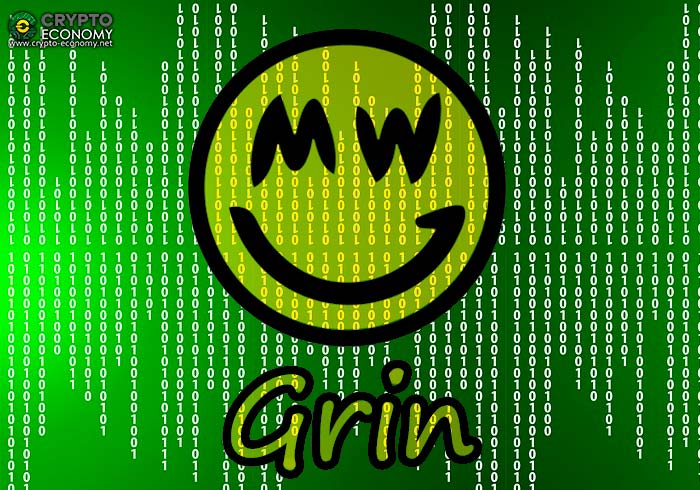Grin [GRIN] with its implementation of the MimbleWimble protocol, is intended to be a scalable privacy currency that does not show addresses or quantities and, therefore, requires less storage than other cryptocurrencies focused on privacy.
Grin is a cryptocurrency created by an anonymous development team, based on the blockchain technology of MimbleWimble, which is distinguished by hiding transactions completely and its scalability, a highly valued aspect in a currency with masive adoption prospects. All transactions are made through wallets that connect directly with each other. The transactions are made anonymous before registering in the blockchain.
Grin, whose official launch was on January 15, 2019, is based on a linear inflation algorithm, where the total offer of the cryptocurrency is unlimited. This project comparing it with its rivals has little time to live, has already gained many followers.
Other features of the Grin cryptocurrency include:
- MimbleWimble protocol, which provides excellent characteristics of anonymity and scaling
- Work Algorithm (Cuckoo Cycle) Work test in two variants called Cuckaroo29 and Cuckatoo31
- Block time relatively fast: one minute
- Fixed block reward over time with a decreasing dilution
- Transaction fees are based on the number of Products created / destroyed and the total size of the transaction
- Smooth curve for difficulty settings
Is Grin’s privacy better than other currencies?
Compare the privacy currencies is not as simple as it seems, in the cryptographic ecosystem, each action requires sharing information with all other users, which makes the privacy is quite limited. For this reason, several cryptocurrency projects have been launched with a specific objective to improve privacy features. Grin is one of these projects.
MimbleWimble
Creation and curiosities of MimbleWinble and Grin
MimbleWimble was created in July 2016 and like bitcoin its authorship is unknown, in this case the person or people behind the project, have used the nickname of Tom Elvis Jedusor to sign this protocol. As a curiosity, we can say that this is the name of the fictional character of Harry Potter, Lord Voldemort, in the French version of the books, plus MimbleWimble is what they call one of the spells used in the saga, by which they tied the victim’s tongue to prevent him from talking about a specific subject.
In August of 2016 Tom Elvis Jedusor, published a link to Mimblewimble in a bitcoin developer chat, which immediately caused great interest among users. The connection of Harry Potter and this project does not end here, because a few months later, a user called the same chat with the nickname of Ignotus Peverell (Another character in the Saga) said he had a project to implement this protocol, the project in issue was Grin, a name that is also linked to the same topic, since it comes from the bank Gringotts, a bank of magicians who they say is the safest place in the world, for anything you want to keep.
Functioning
MimbleWimble combines versions of various cryptographic techniques designed for Bitcoin. In addition, it uses a fairly intelligent maths to completely eliminate the appearance of typical blockchains. The first technique of MimbleWimble is confidential transactions (CT). CT allows users to hide both quantities and addresses in each transaction, so that only two people know the amount involved and addresses in the transaction, namely the sender and the recipient.
Another of the characteristics of MimbleWimble is the scalability, since it maintains the blockchain with a smaller size eliminating all the intermediate states of the UTXO (an unspent transaction result), leaving only the unspent exits in the chain of blocks so the blockchain does not grow with the number of transactions, but with the number of UTXO, aspect that makes it growing slower.
As they say in the official Github of MimbleWinble:
“MimbleWimble is a blockchain format and protocol that provides extremely good scalability, privacy and fungibility by relying on strong cryptographic primordial bases, addressing existing gaps in almost all current blockchain implementations.”
CoinJoin
CoinJoin is a mechanism whereby you combine several transactions in a large transaction, so all senders send money to all recipients at once. The MimbleWimble protocol combines CT and CoinJoin with more intelligent maths and, in the process, eliminates traditional private keys, public keys and addresses, keeping only the inputs and outputs.
Cuckoo Algorithm Proof-of-Work
As they explain in github:
“Cuckoo Cycle is the first working test chart, and the one most linked to memory, but with instant verification. Unlike Hashcash, Cuckoo Cycle is immune to quantum acceleration by Grover’s search algorithm. Cuckatoo Cycle is a variation of Cuckoo Cycle that aims to simplify the ASIC by reducing the ternary counters to simple bits.”
Implementation of the Dandelion protocol
Grin also integrates the Dandelion protocol, which is a solution that provides a higher level of anonymity by hiding the IP address of the blockchain transactions. This protocol was created thanks to the collaboration of specialists from Carnegie Mellon, the Massachusetts Institute of Technology (MIT) and the University of Illinois.
Dandelion works in two phases, the main phase is where the protocol reduces the ability to show the IP address of the originating node, increasing anonymity. In this phase, through an algorithm, the node transmits the transaction message to a random node, this node only transmits the transaction message to another node, this process continues until one of the nodes begins to spread the message to the rest of the network.
At this point begins the Spreading phase (propagation phase), where a single node transmits a message that propagates rapidly to most nodes in the network, the sum of these phases increase the difficulty when it comes to tracking the node original and therefore the identity of the sender.
Grin’s monetary policy
Currently Grin has an unlimited supply, which means that there is no limit on the issuance of coins, the cryptocurrency will not have any halving, which means that the reward received by the miners per block will remain stable at 60 Grin.
From the Github of MimbleWimble they comment:
“Grin’s inflation rate can discourage hoarding and improve its distribution, which discourages “whales”, which otherwise have an excessive amount of control over the price of an asset, and minimizes speculative bubbles and changes in prices … The constant issuance could provide greater security in supply / demand for all types of users, and allow a transparent and natural price.”
Grin mining calculator
If you are interested in mining this cryptocurrency, from Crypto-Economy we put at your disposal a Grin calculator where you can see the profitability and expenses incurred through the mining of Grin and other cryptocurrencies.











